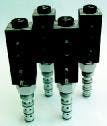Cartridge style valves fit size 10 cavities and are solenoid-operated, 4-way, 3-position valves that reach flows to 10 gpm at pressure of 5000 psi. Configurations include tandem center, open center, closed center, and motor spool. Uni-body design and oversized seating allow high-torque tightening during installation, eliminating locking mechanisms or lock wires. Low or high wattage solenoid coils offer continuous duty.
Command Controls Corp., (847) 429-0700, www.commandcontrols.com


